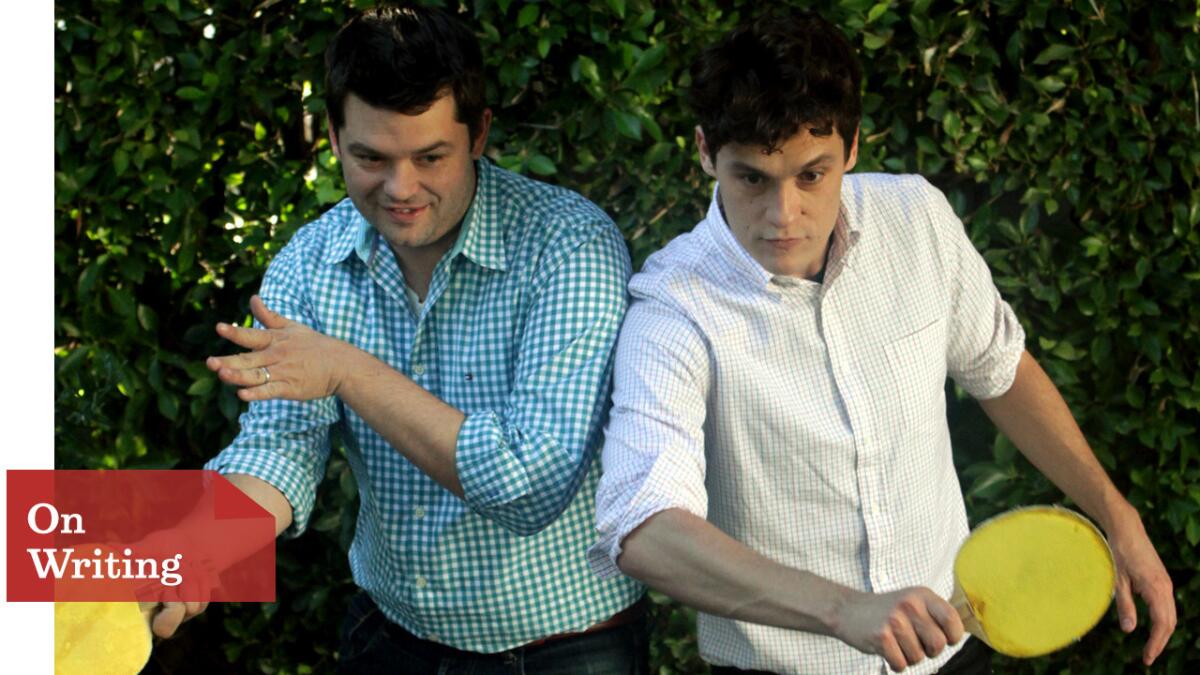The Envelope: Writers built ‘The Lego Movie,’ block by block, on belief

- Share via
“They’ll never let us do this.”
We were proposing to make a major studio movie look like it was made in someone’s basement. The characters wouldn’t have fingers. Or knees. Or noses. Our story involved licensed characters from at least three different movie studios. We would need permission from J.K. Rowling, George Lucas, Christopher Nolan and the NBA. Not to mention the Lego Group, which wasn’t entirely convinced it needed to make a movie in the first place. Not to mention a Third Act twist sequence that we weren’t sure was going to actually work.
“Well, let’s just pitch it fast and maybe they won’t realize how crazy this is.”
So began “The Lego Movie.”
It was an audacious thing to attempt in feature animation. We wanted to use cutting-edge computer technology to make something as rough-hewn and messy as an amateur film. We were making a movie about a toy that inspires creativity. And we thought if we embraced the limitations of the medium, it would inspire creative solutions.
So every frame had to feel like anyone could have made it at home, if that “anyone” had millions of Lego bricks and sophisticated lighting equipment. Knees and elbows had to stay stiff. Explosions and water, even motion blur, had to be made of Lego bricks. Every brick would need computer-generated fingerprints and scratches and hair and (ew) dandruff. We had a two-hour meeting to decide how much dandruff there should be in the movie. The surprising answer: “Some.”
We took over the Animal Logic offices in Santa Monica, basically a big warehouse, far away from daily supervision. Chris McKay, our co-director, had the idea to start every day with an all-crew meeting. Designers, artists, editors, production coordinators. Even the IT guy. No agenda. Just a meeting to talk about one another’s work, tell jokes and get the creative juices flowing. Unquestionably, a very inefficient meeting.
Occasionally something great would come out of it. One of the assistant editors mentioned he had built a double-decker couch in his apartment once. A week later it had worked its way into an artists’ storyboard. We worked it into the script, and by the time the movie came out, the double-decker couch had become a major story point.
Instead of running a gantlet of formal storyboard reviews, we asked that artists and editors work quickly back and forth, without a lot of time for refinement, because we knew that, like a Lego creation itself, we were going to take the whole thing apart and rebuild it again and again. The same thing went for our actors and our design team and our animators. Each step was designed to evolve the story, make a character more distinctive, get to the core emotional truth of a relationship, add a joke and, more than anything, imbue the film with something that a movie about Lego had to have: a sense of creative empowerment.
A lot of movies follow the pattern of the Hero’s Journey, an archetypal story about a hero who is one in a million. An extraordinary talent preordained to be the only person who can save humankind. Our problem with that is that it lets the rest of humankind off the hook. We wanted to see if we could make a hero’s journey story where the hero was not extraordinary but extra ordinary — with no special talent whatsoever, who could be any one of us. If we could pull that off, maybe we could make a movie that empowered every person who saw it.
So just like those movies, we had a prophecy. We even got Morgan Freeman to say it. But we also got Morgan Freeman to tell the hero that the prophecy was a fiction. And that anyone who chose to believe it could fulfill it.
We set out to use a big commercial studio film as a Trojan horse to relay a message about the power and necessity of grass-roots creativity. We wanted to make a movie that made you feel more creative when you walked out than when you walked in.
Every movie is an attempt to answer some big question, and we had found ours: Can we make someone an artist just by telling them they are?
We sure hope so.
But it’s not like we’re scientists or something. We don’t know.
We’re artists. We don’t know anything. We just believe.
More to Read
Sign up for The Envelope
Get exclusive awards season news, in-depth interviews and columnist Glenn Whipp’s must-read analysis straight to your inbox.
You may occasionally receive promotional content from the Los Angeles Times.








